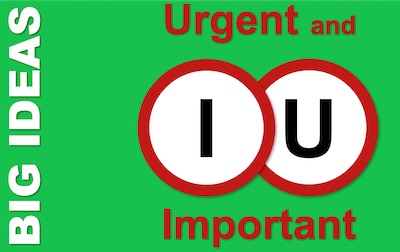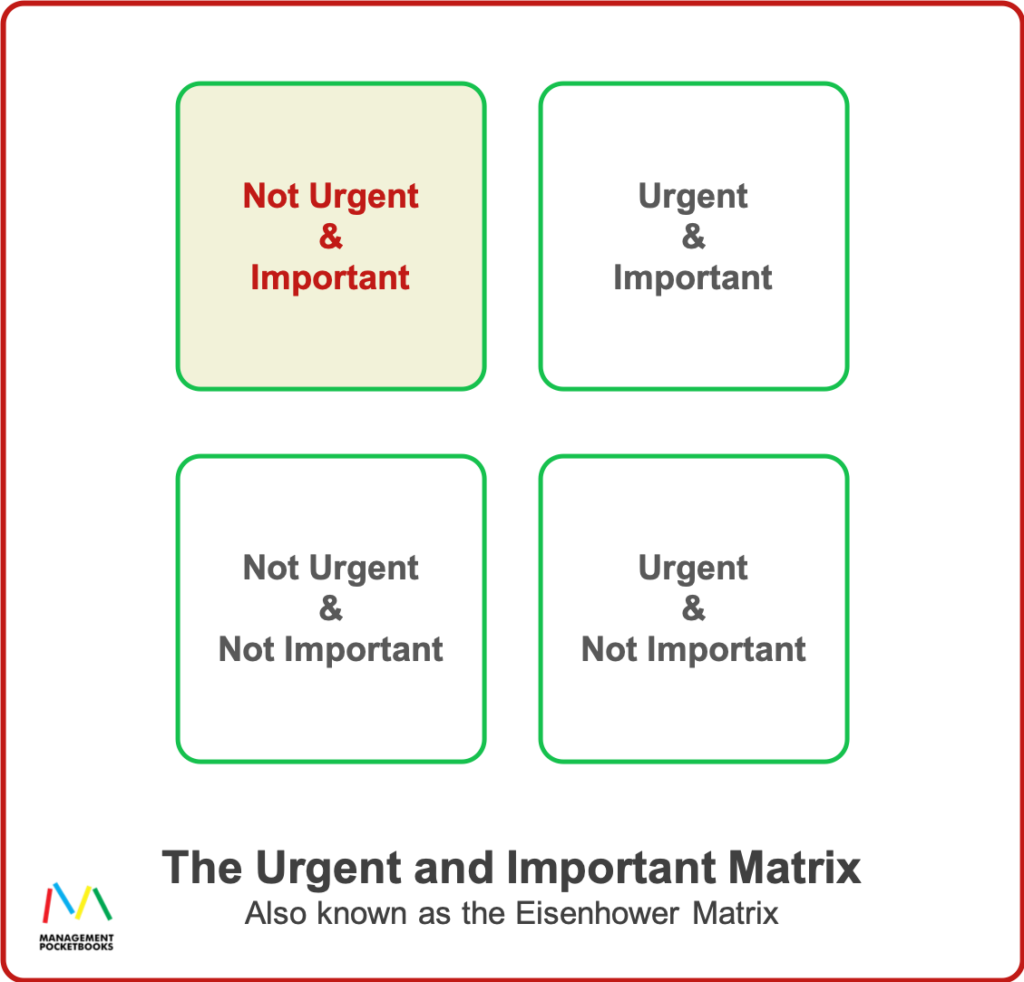
 The distinction between urgent and important is an essential one. It’s a staple of time management, and rightly so.
The distinction between urgent and important is an essential one. It’s a staple of time management, and rightly so.
It was first popularised by President Dwight D Eisenhower, but has been picked up by generations of productivity advisors. When you understand what is important, and distinguish those things from others that are merely urgent, you gain real control of how you use your time.
So, urgent and important – or more properly, the distinction between them – is truly a big idea.
Why Distinguish between Urgent and Important?
Are you like many of us? Do you find that your days constantly get hijacked by urgent tasks, so that you rarely feel in control of your diary – much less the events around you?
If you are President of the United States, that must be a big problem. Even when news cycles were longer and the only social media that mattered were the personal columns in the newspapers.
It’s certainly what President Eisenhower found, and the following quote is attributed to him:
‘Most things which are urgent are not important, and things which are important are not urgent.’
The distinction is valuable because it allows us to recognise that our sense of urgency may be the indication we need. Perhaps it’s telling us that, paradoxically, this is something we don’t need to attend to.
What we do need to attend to are the things that make a difference:
- to us
- our family and friends
- our organisation
- and to our world
What is Urgent and Important?
In its best-known form, the distinction between urgent and important has transformed into a matrix; often known as the Eisenhower Matrix.
Stephen Covey picked up on this idea and put it at the core of one of his Seven Habits of Highly Effective People, in his best-selling book of the same name (US|UK).
Put First Things First
Putting first things first was Covey’s third habit. And it’s all about having the discipline to prioritise what is important over what is merely urgent. Covey presents the Eisenhower Matrix, identifying the kinds of activities that fall into each of its four quadrants. For example:
- Urgent and Important activities include crises and deadline-driven projects
- Urgent and Not Important activities include interruptions and a lot of your meetings
- Not Urgent and Not Important activities include time wasters and trivia
- Not Urgent but Important activities are strategic tasks like planning, self-care, seizing opportunities, and building relationships
Covey concludes that a focus on the Important but Not Urgent activities in his Quadrant II leads to balance, control and vision.
Finding what is important and putting that first is part of Covey’s formula for success.
How to Use the Urgent and Important Matrix
For me, this remains one of the most powerful practical time and productivity management tools. Here’s one way I advocate using it.
- Draw yourself a large chart
- Make yourself a list of everything on your agenda. You may already have an unruly To Do list, so this is a great way to tame it.
- Set yourself a definition for Urgent. It may be that you are under pressure to do this by the end of the week, or that you feel compelled to do it, despite another feeling that you don’t need to.
- Set yourself a definition of Important. This will likely link to your goals or what matters most to you, in your work, your family, your life, etc.
- Now allocate each thing in your list to one of your four boxes. Be ruthless. Make sure it really does meet the definitions you set yourself.
What to Do with Each Box
Views differ about the strategy for each box, but here are my suggestions:
- Urgent and Important activities need your attention quickly. But they also need high-quality attention. Schedule the first opportunity to attend to them properly.
- Urgent and Not Important activities may not be important enough to worry about. So, ask yourself if delaying them until they are time-expired will have any genuinely adverse consequences. But, if you do need to do them, give them the least attention that you can, consistent with what little importance they do have. This may mean outsourcing them to an assistant or junior colleague, or batching them up and doing them as quickly as you can.
- Not Urgent and Not Important activities are simply a waste of your valuable time. Release yourself from the mental shackles of these tasks by deleting them from your To Do list now. Done. [Note: if they turn out to be more urgent or more important than your assessment suggests, then they will come back onto your radar.]
- Not Urgent but Important activities are where the gold is. Here’s where you invest your effort for big future returns. So schedule big chunks of your most productive time to give these tasks the attention they deserve. This will help you get ahead of crises and feel in control of your life. Better yet, doing the important but not urgent tasks well will create the improvements in our work and your life that you want.
What is Your experience of the Urgent and Important Matrix?
We’d love to hear your experiences, ideas, and questions. Please leave them in the comments below.
To learn more…
The Time Management Pocketbook is full of tips, techniques, and tools for those who want to make effective use of their business time. It includes a short summary of Urgent and Important.
The Management Models Pocketbook is a great resource for trainers and a ready-reference for managers. It contains a detailed analysis of the Urgent and Important idea.

